Hurricanes Carol and Edna
Unleash Fury on Maine
by Tom Seymour
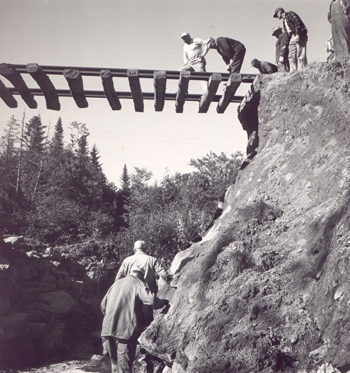
On September 12, 1954, Hurricane Edna struck New England killing eight people. After the storm, sagging and unsupported ties were common sights throughout the Bangor and Aroostook railroad system. Train service was virtually non-existent the first 48 hours after the storm. Track forces were quickly mobilized and work begun on the 157 washouts caused by the storm. Photo: Collection of Oakfield Historical Society.
What could be worse than a devastating killer hurricane? Two hurricanes, 10 days apart.
Maine, being far to the northeast, was never very hurricane-prone. Most of the debilitating hurricanes that strike the Atlantic coast become downgraded to tropical storm status by the time they reach the Pine Tree State. But every so often something happens that shatters the norm. And in 1954, Hurricane Carol did just that.
Carol began as a tropical depression off the Florida coast on August 25, 1954. By that afternoon, she achieved tropical storm status. The following day Carol became a category 1 hurricane. Then on August 27, Carol became a Category 2 hurricane with 100-m.p.h. winds. And on September 1, 1954, Hurricane Carol unleashed her fury on Maine.
Maine suffered greatly from Carol’s power. Three persons died from storm-related causes and damages ran up to 10 million dollars. That amount equals over 100 million in today’s dollars.
Edna is credited with
the deaths of eight people
in Maine, all from
drowning.
Maine wasn’t alone in storm damage, loss and suffering. The other four New England states suffered as well, as winds tore down the spire in Old North Church in Boston, the place where the signal was given to Paul Revere to commence upon his historic ride. And in Providence, Rhode Island, water from the storm surge reached an incredible 12 feet. In Maine, the powerful winds uprooted or broke many hundreds of trees. In New England as a whole, 65 persons died in the storm and 1,000 were injured.

Old North Church steeple blown over during hurricane Carol in 1954. The steeple is where lanterns were hung to signal Paul Revere to commence upon his historic ride in 1775.
Hurricane Carol had the dubious distinction of being the first named hurricane to strike Maine. The storm was so vicious, so devastating, that the name “Carol” was retired, never to be used again.
Total damage throughout New England amounted to $642 million. Crop damage was equally shocking, with the loss of close to 40 percent of that year’s fruit and vegetable crops. One-third of New England residents lost their electric service.
Hurricane Edna
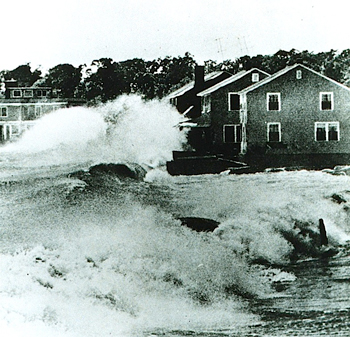
Hundreds of summer homes along the Massachusetts coast are battered by storm surge surf.
While Maine and New England were just beginning to assess the damage from Hurricane Carol, another hurricane hit the Pine Tree State. On September 11, 1954, Hurricane Edna smashed into Maine and New Hampshire. Hurricane Edna first made landfall on Cape Cod, Massachusetts and quickly spread to the Gulf of Maine and then inland from there. Edna is credited with the deaths of eight people in Maine, all from drowning. Also, in Unity, 10 people waited out the floodwaters atop their car, the only place they found to escape from drowning. Nine of the 10 were finally rescued when good Samaritans formed a human chain. One person lost in this incident was an 8-year-old girl who was lost when her father lost his grip. Another person on the scene, one of the rescuers, a 47-year-old man, was swept away by the raging water.
As an aside, bear in mind that even one person sitting atop a car today would damage the roof, but in 1954, metal wasn’t rolled as thin and car roofs were as a consequence, very strong.
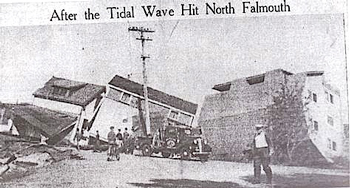
Houses thrown from their foundations in North Falmouth by a tidal wave.
Winds from Hurricane Edna weren’t as strong as those of Hurricane Carol, but at 74 m.p.h., were sufficient to knock down huge trees and cause considerable property damage. Rain from Edna measured 7.5 inches. The ground was already saturated from Hurricane Carol and runoff caused huge problems, carving out roadways and railroad embankments.
The Kennebec and Androscoggin rivers were hit particularly hard, with numerous road washouts. At Augusta, high water measurements showed that the river had risen 20 feet above median level. The Rockland/Rockport Movie Theater, a drive-in theater, was leveled. Also, highways and railroads were rendered unserviceable. In all, eight people in Maine drowned as a result of Hurricane Edna and 20 percent of the state lost electric power. Hurricane Edna was the costliest hurricane ever for Maine.
See It Now
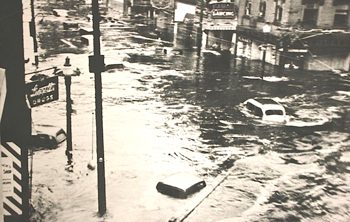
Providence, Rhode Island where water from the storm surge reached an incredible 12 feet.
World-renowned journalist Edward R. Murrow, along with his CBS television team for his show, See It Now, flew in a U.S. Air Force “Hurricane Hunter” to get a bird’s-eye view of Hurricane Edna. Hurricane research was not yet in place, but Murrow’s flight helped to remedy that situation.
At the end of the flight, Murrow uttered his now-famous words, “In the eye of a hurricane, you learn things other than of a scientific nature. You feel the puniness of man and his works. If a true definition of humility is ever written, it might well be written in the eye of a hurricane.”
Later in 1954, the U.S. Congress allotted funds to the U.S. Weather Bureau to create the National Hurricane Research Project. From then on, science took note on how hurricanes formed, behaved and evolved.
At Augusta, high water measurements showed that
the river had risen 20 feet
above median level.
Another famous personage was caught up in Hurricane Edna. Writer E.B. White, living in Maine at the time, listened to his radios as reports of impending doom from Edna filtered in. White had no television, but he had two radios and his wife has one of her own.
White wrote his essay, “The Eye of Edna,” about the lead-up to the hurricane making landfall in Maine. The gist of it was that reporting tended to get people worked up and overly excited about the approaching storm. Such reporting, now seen on television sets worldwide, continues to this day. Reporters stand outside in fair weather, telling viewers that a terrible storm is just hours away. Tension builds and when the first winds began rippling waters and shaking poplar leaves, the stage is set.
E.B. White apprehended all of this in his somewhat tongue-in-cheek essay.
Because of the tremendous damage Hurricane Edna extracted from the northeast, the name Edna, like Carol, was forever deleted from the repository of potential names for future hurricanes.
Then Came Donna
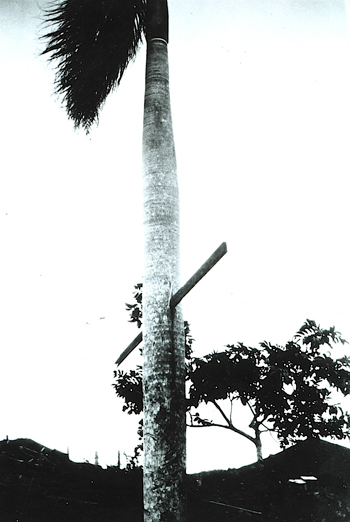
Palm tree punctured by a 2x4 illustrates the force of high winds from hurricane Andrew. Photos from collections Oakfield Historical Society.
According to records from the Blue Hill Observatory in Milton, Massachusetts, wind gusts from Hurricane Donna hit 140 m.p.h. at 6 p.m. on September 12, 1960. And by 8 p.m., Donna had swept through New Hampshire and began battering Maine.
According to a report in Revolvy, 15-20 boats were damaged as they sat on their moorings in the harbor at Falmouth, Maine. Damage to all boats was estimated at $250,000. Residents of coastal areas, especially those living in flood-prone beach situations, were evacuated.
Moving up the coast, lightning associated with Hurricane Donna hit Dirigo Hotel in Southwest Harbor, causing $100,000 in damage. The twin cities of Auburn-Lewiston were without telephone or electric power. Along with trees, television antennas were snapped like twigs. Besides all this, nearly 40 percent of Maine’s apple crop was destroyed.
In all, from the Lesser Antilles to Maine, 364 persons were killed and property damage came in at $900 million.
Like Hurricanes Carol and Edna, the name “Donna” was forever deleted, never to be used again as the name for an Atlantic hurricane.
The Atlantic hurricane season begins on June 1, and while named hurricanes seldom strike Maine, the storms Carol, Edna and Donna stand in silent testimony that Maine is not exempt from true hurricanes.
